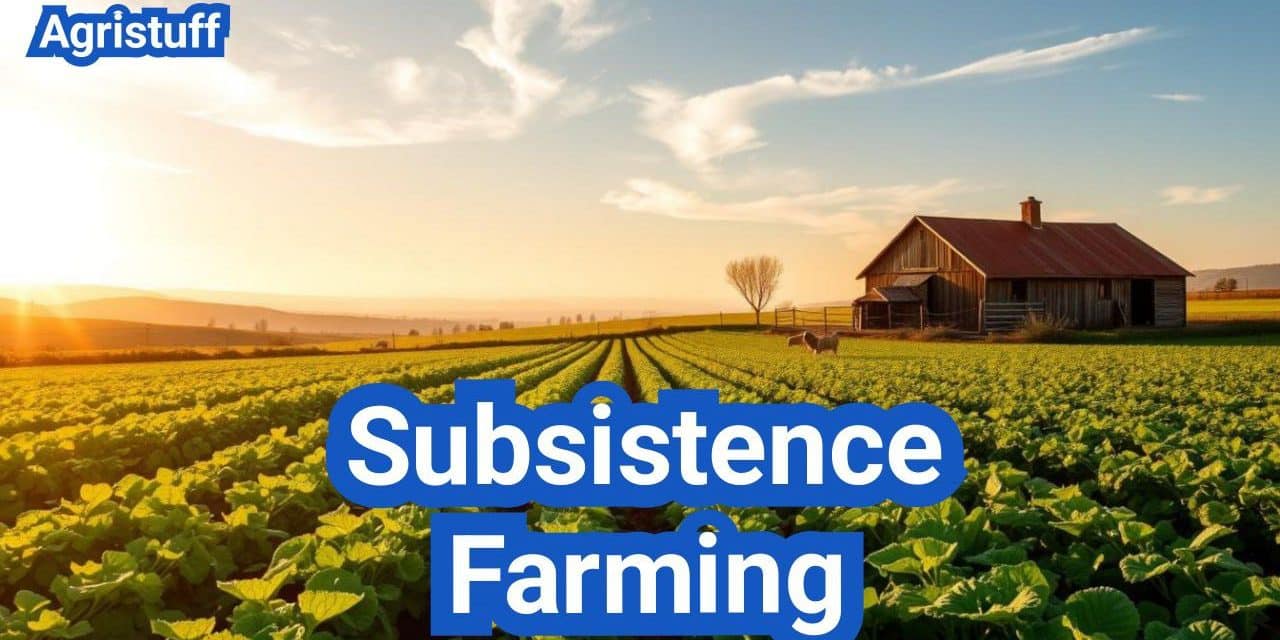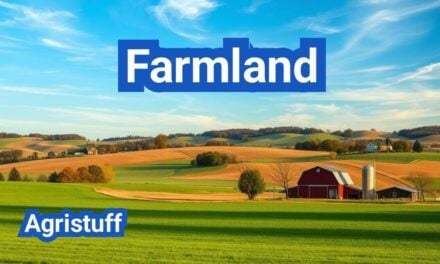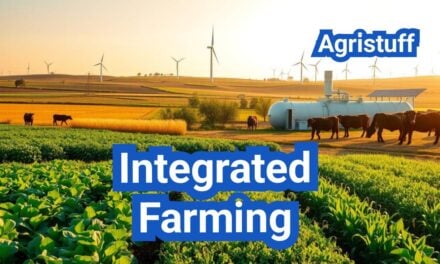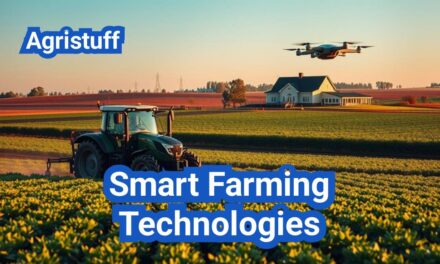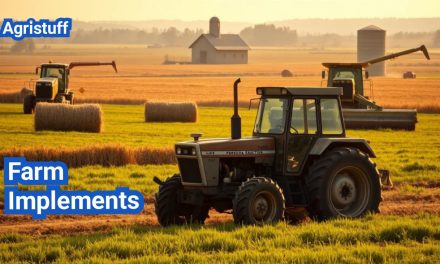Agricultural self-sufficiency ( Subsistence farming ) is a vital aspect of many communities worldwide. At its core is subsistence farming, a practice where families grow crops and raise livestock primarily for their own consumption.
This traditional method of farming is crucial for ensuring food security, particularly in rural areas where access to external food sources may be limited. By understanding the principles of small-scale farming and its role in sustainable agriculture, we can better appreciate its significance in today’s world.
Key Takeaways
- Subsistence farming is a vital practice for ensuring food security in many communities.
- It involves growing crops and raising livestock primarily for personal consumption.
- This traditional farming method promotes agricultural self-sufficiency.
- Small-scale farming plays a significant role in sustainable agriculture.
- Understanding subsistence farming is essential for appreciating its importance in today’s world.
Understanding Subsistence Farming
At its core, subsistence farming is about cultivating the land to meet the basic needs of a family or community. This agricultural practice has been a cornerstone of human civilization, providing sustenance and livelihood to countless individuals around the world.
Definition and Core Concepts
Subsistence farming is characterized by its focus on growing food crops and raising livestock primarily for the consumption of the farmer’s family. The primary goal is not to produce surplus for sale but to ensure food security. This type of farming is often associated with rural or remote areas where access to markets may be limited.
The core concepts of subsistence farming include the use of traditional farming techniques, reliance on family labor, and minimal use of external inputs such as fertilizers and machinery. This approach to farming is deeply intertwined with the local culture and traditions, making it a vital part of the community’s identity.
Historical Context and Evolution
Subsistence farming has a rich history that dates back thousands of years, with evidence of its practice found in various ancient civilizations. Over time, it has evolved in response to changing environmental conditions, technological advancements, and socio-economic factors.
Historically, subsistence farming was the primary means of food production, allowing communities to be self-sufficient. As societies developed and trade networks expanded, some subsistence farmers began to produce surplus crops for exchange, gradually integrating into the market economy.
Subsistence vs. Commercial Farming
The distinction between subsistence and commercial farming lies in their objectives and operational scales. While subsistence farming is centered on meeting the family’s food needs, commercial farming is driven by the goal of generating profit through the sale of agricultural products.
- Subsistence farming is typically small-scale and labor-intensive.
- Commercial farming often involves large-scale production and mechanization.
- The use of technology and external inputs is more prevalent in commercial farming.
Understanding the differences between these two farming practices is crucial for appreciating the role of subsistence farming in food security and rural development.
Key Characteristics of Subsistence Agriculture

Subsistence agriculture stands out due to its emphasis on family-based labor and minimal use of external inputs. This form of agriculture is fundamentally different from commercial farming, focusing on producing food primarily for the farmer’s family.
Small-Scale Production Methods
Subsistence farming is characterized by small-scale production methods. Farmers typically cultivate small plots of land, often using traditional techniques passed down through generations. The produce is mainly for household consumption, with any surplus potentially sold or stored for future use.
- Use of traditional crop varieties
- Manual labor or simple tools
- Minimal use of machinery or technology
Family-Based Labor Organization
Another defining feature of subsistence agriculture is its reliance on family-based labor. Family members are involved in various stages of farming, from planting to harvesting. This not only reduces labor costs but also strengthens family bonds and ensures the transfer of knowledge and skills to younger generations.
- Family members contribute labor
- Knowledge and skills are passed down
- Enhances family cohesion
Limited Technology and Input Usage
Subsistence farmers typically have limited access to technology and external inputs such as fertilizers, pesticides, and irrigation systems. This limitation is often due to financial constraints or lack of infrastructure in rural areas. As a result, subsistence farming practices tend to be more environmentally friendly, relying on natural soil fertility and local ecosystem services.
- Minimal use of chemical fertilizers and pesticides
- Reliance on natural soil fertility
- Use of local ecosystem services
Types of Subsistence Farming Systems
The diversity in subsistence farming systems reflects the wide range of ecological and cultural contexts in which they are practiced. These systems have evolved over time to suit specific environmental conditions, technological levels, and socio-economic needs.
Intensive Subsistence Farming
Intensive subsistence farming involves the cultivation of a small area of land with a high level of labor and inputs to maximize yield. This method is often practiced in densely populated areas where land is scarce. High crop yields are achieved through the use of fertilizers, irrigation, and other intensive agricultural practices.
Shifting Cultivation Systems
Shifting cultivation, also known as slash-and-burn agriculture, is a system where land is cleared by burning vegetation, cropped for a few years, and then left to fallow. This practice is common in tropical regions and allows for the regeneration of soil fertility. The cycle of clearing, cropping, and fallowing is repeated over time.
Sedentary Farming Practices
Sedentary farming involves farming the same plot of land continuously, often with the use of techniques like crop rotation and manuring to maintain soil fertility. This system is more stable and sustainable compared to shifting cultivation. Sedentary farming allows for the development of more permanent settlements and can support larger populations.
Nomadic Herding
Nomadic herding involves the movement of livestock from one grazing area to another in search of pasture and water. This practice is typical in arid and semi-arid regions where grazing resources are scarce and variable. Nomadic herders have a deep understanding of the environment and migrate with their animals to optimize grazing opportunities.
Each of these subsistence farming systems has its unique characteristics, advantages, and challenges. Understanding these different systems is crucial for developing appropriate support strategies and policies that can enhance their productivity and sustainability.
The Importance of Subsistence Farming

Subsistence farming plays a crucial role in maintaining food security, cultural heritage, and economic stability in rural communities. This type of farming is not just a means of survival; it is deeply intertwined with the social fabric and cultural identity of the communities that practice it.
Food Security Contributions
One of the primary importance of subsistence farming is its contribution to food security. By growing their own food, families can ensure a steady supply of nutritious meals, even in times of economic hardship or when market access is limited. Subsistence farming provides a safety net against food insecurity, allowing families to maintain their health and well-being.
The table below highlights the key aspects of how subsistence farming contributes to food security:
| Aspect | Description | Benefit |
|---|---|---|
| Food Production | Growing a variety of crops | Diverse diet and nutrition |
| Food Storage | Preserving food for future use | Year-round food availability |
| Food Distribution | Sharing surplus within the community | Social cohesion and support |
Cultural and Social Significance
Subsistence farming is also deeply rooted in the cultural and social practices of the communities that engage in it. It is often a family-oriented activity that involves passing down knowledge and skills from one generation to the next. This continuity helps preserve cultural heritage and traditional practices, maintaining the community’s identity.
Economic Impact in Rural Communities
In addition to its social and cultural significance, subsistence farming has a tangible economic impact on rural communities. By producing their own food, households can reduce their expenditure on food purchases, thereby saving money that can be used for other essential needs. Furthermore, any surplus produce can be sold or traded, providing a small but vital source of income.
The economic benefits of subsistence farming can be summarized as follows:
- Reduced household expenditure on food
- Potential income from selling surplus produce
- Stimulation of local economies through trade
In conclusion, subsistence farming is vital for ensuring food security, preserving cultural heritage, and supporting the economic stability of rural communities. Its importance cannot be overstated, and efforts to support and sustain subsistence farming practices are crucial for the well-being of these communities.
How to Start Your Subsistence Farm
Before diving into subsistence farming, it’s essential to conduct a thorough assessment of your land and available resources. Starting a subsistence farm is a significant undertaking that requires careful planning and execution.
Assessing Your Land and Resources
The first step in establishing a subsistence farm is to evaluate the land and resources at your disposal. This includes assessing the quality of your soil, the availability of water, and the local climate conditions. A thorough assessment will help you determine the most suitable crops and farming practices for your specific situation.
Consider conducting soil tests to determine its pH level and nutrient content. This information will be crucial in deciding which crops to plant and how to manage your soil effectively.
Setting Realistic Self-Sufficiency Goals
Setting achievable self-sufficiency goals is vital to the success of your subsistence farm. Begin by identifying your primary needs, such as food production, and then set specific, measurable objectives. Consider factors like the size of your family, dietary preferences, and the resources required to meet your goals.
It’s also important to be realistic about your capabilities and the challenges you may face. Starting small and gradually expanding your operations as you gain experience is often a more effective strategy.
Essential Tools and Equipment Selection
Selecting the right tools and equipment is crucial for the efficient operation of your subsistence farm. Begin with the basics, such as a hoe, shovel, and rake, which are essential for most farming tasks. As you expand your operations, you may need to invest in additional equipment, such as a plow or irrigation system.
Consider the cost, durability, and maintenance requirements of any tool or equipment before making a purchase. It’s also worth exploring options for repurposing or adapting existing tools to meet your needs.
Planning Your Subsistence Farm Layout

A well-designed farm layout is the backbone of a successful subsistence farming operation. It not only enhances productivity but also ensures sustainability by making the most of available resources.
Efficient Space Utilization Strategies
Efficient use of space is critical in subsistence farming, where resources are often limited. One effective strategy is to use vertical gardening techniques, such as trellises or stacked beds, to maximize growing areas. Additionally, implementing companion planting can help optimize space by pairing crops that benefit from each other’s growth.
To further enhance space utilization, consider the mature size of plants when spacing them. Overcrowding can lead to reduced yields and increased disease susceptibility. A well-planned layout also facilitates easier access for maintenance and harvesting.
Implementing Effective Crop Rotation
Crop rotation is a vital practice in subsistence farming, helping to maintain soil fertility and reduce pest and disease pressure. A simple rotation plan can involve alternating between legumes and non-legumes or between root crops and leafy greens.
| Crop Type | Benefits | Rotation Considerations |
|---|---|---|
| Legumes | Fix nitrogen in soil | Follow with nitrogen-hungry crops |
| Root Crops | Break soil compaction | Rotate with leafy greens for diversity |
| Leafy Greens | Quick growth cycle | Can be followed by heavier feeders |
Integrating Livestock and Garden Areas
Integrating livestock into your subsistence farm can enhance overall productivity and create a more diverse and resilient farming system. Consider allocating areas for animal grazing and fodder production. Ensure that livestock areas are well-fenced to prevent damage to crops.
Using agroforestry practices, where trees are integrated into farming systems, can also provide multiple benefits, including shade for livestock and additional income streams from tree products.
Choosing Suitable Subsistence Crops
The success of a subsistence farm hinges on the careful selection of crops that are well-suited to the local climate, soil, and cultural preferences. Choosing the right crops is essential for food security and a successful subsistence farm.
Staple Crops for Food Security
Staple crops are fundamental to food security in subsistence farming. These crops provide the primary source of nutrition and energy for the family. Common staple crops include maize, rice, and potatoes, which are rich in carbohydrates and can be stored for long periods.
When selecting staple crops, it’s crucial to consider factors such as soil type, climate, and the family’s dietary preferences. For instance, in regions with poor soil quality, crops like sweet potatoes or cassava might be more suitable due to their hardiness and nutritional value.
| Crop | Nutritional Value | Storage Life |
|---|---|---|
| Maize | Rich in carbohydrates, fiber, and vitamins | Up to 2 years with proper drying and storage |
| Rice | High in carbohydrates, low in fiber | Long-term storage possible with correct drying |
| Potatoes | Good source of carbohydrates, vitamin C, and potassium | Several months under cool, dark conditions |
Fast-Growing Seasonal Vegetables
Incorporating fast-growing seasonal vegetables into a subsistence farm can provide a continuous supply of fresh produce. These vegetables can be harvested in as little as 20 days and can be grown in succession to ensure a steady supply.
Examples of fast-growing vegetables include lettuce, spinach, and radishes. These crops are not only quick to mature but also provide essential vitamins and minerals, enhancing the family’s diet.
Perennial Food Plants and Trees
Perennial food plants and trees offer a sustainable and long-term solution for food production. They require less labor over time and can provide a consistent yield year after year.
Crops like bananas, avocados, and mangoes are excellent examples of perennial food sources. They not only provide food but also contribute to soil health and biodiversity.
Climate-Appropriate Crop Selection
Selecting crops that are appropriate for the local climate is crucial for the success of a subsistence farm. This involves understanding the local rainfall patterns, temperature ranges, and soil conditions.
For example, in arid regions, drought-resistant crops like sorghum and millet are ideal. In contrast, in tropical regions with high rainfall, crops like cassava and yams can thrive.
By carefully choosing crops that are well-suited to the local climate and soil conditions, subsistence farmers can improve their chances of success and enhance their food security.
Incorporating Livestock in Subsistence Farming

Livestock plays a crucial role in subsistence farming, offering a diverse range of benefits for farmers and their communities. By integrating livestock into their farming systems, subsistence farmers can enhance food security, improve income stability, and promote overall agricultural sustainability.
Small Animal Husbandry Techniques
Small animal husbandry involves the care and management of smaller livestock such as chickens, ducks, goats, and rabbits. These animals are often more manageable for subsistence farmers due to their relatively low space and feed requirements. Effective small animal husbandry techniques include providing adequate shelter, nutrition, and health care.
Key Practices:
- Providing shelter that protects animals from predators and harsh weather conditions.
- Ensuring access to clean water and nutritious feed.
- Implementing regular health checks and vaccinations.
Selecting Dual-Purpose Livestock Breeds
Dual-purpose livestock breeds are those that can be used for more than one product, such as cattle that provide both milk and meat. Selecting the right breed is crucial for maximizing the benefits of livestock in subsistence farming.
Considerations for Breed Selection:
- Climate adaptability.
- Disease resistance.
- Feed efficiency.
- Productivity (milk, meat, eggs, etc.).
On-Farm Feed Production and Management
On-farm feed production is a critical aspect of sustainable livestock management. By growing their own feed, farmers can reduce reliance on external inputs and lower costs.
Strategies for Effective Feed Production:
- Cultivating high-yielding crop varieties suitable for animal feed.
- Implementing crop rotation to maintain soil fertility.
- Utilizing crop residues and by-products as feed.
| Livestock Type | Feed Requirements | Labor Needs | Benefits |
|---|---|---|---|
| Chickens | Low to Moderate | Low | Eggs, Meat |
| Goats | Moderate | Moderate | Milk, Meat, Manure |
| Cattle | High | High | Milk, Meat, Labor |
Sustainable Practices for Subsistence Farming

To ensure the viability of subsistence farming, adopting sustainable practices is essential. These practices not only help in maintaining the health of the farm ecosystem but also contribute to the overall well-being of the farming community.
Water Conservation and Management
Effective water conservation is critical in subsistence farming. Techniques such as rainwater harvesting and the use of drip irrigation systems can significantly reduce water waste. Additionally, mulching helps retain soil moisture, reducing the need for frequent watering.
Implementing these water-saving methods not only conserves this vital resource but also helps farmers become more resilient to droughts and other climate-related challenges.
Natural Pest and Disease Management
Managing pests and diseases without relying on chemical pesticides is a key aspect of sustainable subsistence farming. Techniques such as crop rotation, biological control, and the use of organic pesticides are effective methods. Crop rotation, for instance, can break the life cycle of pests, while biological control involves introducing natural predators of the pests.
Using natural pest management strategies not only protects the environment but also ensures that the produce is safe for consumption.
Maintaining Soil Fertility Naturally
Maintaining soil fertility is crucial for the long-term productivity of subsistence farms. Practices such as composting, cover cropping, and integrating legumes into crop rotations can enhance soil health. Composting, for example, recycles organic waste into a nutrient-rich fertilizer that improves soil structure and fertility.
By adopting these sustainable practices, subsistence farmers can improve their soil’s fertility naturally, ensuring sustained agricultural productivity.
Traditional and Indigenous Farming Methods

For generations, indigenous communities have employed traditional farming techniques that not only ensure food security but also preserve cultural heritage. These time-honored practices have been passed down through generations, offering valuable insights into sustainable agriculture and environmental stewardship.
Time-Tested Agricultural Techniques
Traditional farming methods encompass a wide range of techniques that have been refined over centuries. Some of these include:
- Crop rotation and intercropping to enhance soil fertility and reduce pests and diseases
- Use of organic amendments like compost and manure to maintain soil health
- Conservation of water through traditional irrigation systems and rainwater harvesting
- Integration of livestock into farming systems for diversified production
These techniques not only promote ecological balance but also contribute to the resilience of farming systems in the face of climate change.
Adapting Ancient Wisdom to Modern Challenges
In today’s world, where sustainability is becoming increasingly important, traditional farming methods offer valuable lessons. By adapting ancient wisdom to modern challenges, farmers can:
- Enhance biodiversity through the use of diverse crop and animal varieties
- Improve soil health using natural methods, reducing the need for synthetic fertilizers
- Implement efficient water management practices that are crucial in the face of climate change
By combining traditional knowledge with modern innovations, farmers can create more sustainable and resilient farming systems.
Preserving Agricultural Heritage
Preserving agricultural heritage is crucial not only for maintaining cultural identity but also for ensuring the continuation of valuable farming practices. Efforts to preserve this heritage include:
- Documenting traditional farming practices and the knowledge associated with them
- Supporting indigenous communities in their efforts to maintain their farming traditions
- Promoting the importance of agricultural heritage in educational and community programs
By preserving agricultural heritage, we can ensure that future generations have access to the knowledge and practices that have sustained communities for centuries.
The Role of Women in Subsistence Agriculture

The role of women in subsistence agriculture is multifaceted, encompassing historical knowledge, labor, and innovation. Women play a vital role in subsistence agriculture, contributing to food security and household well-being. Their involvement is crucial for the sustainability of subsistence farming systems.
Historical Contributions and Knowledge
Women have historically been key players in subsistence agriculture, bringing with them traditional knowledge and practices passed down through generations. They have been instrumental in preserving crop diversity, developing local farming techniques, and managing natural resources.
Preservation of Traditional Knowledge: Women often serve as guardians of traditional farming practices, including crop selection, soil management, and harvesting techniques. This knowledge is crucial for the resilience of subsistence farming systems.
Current Challenges and Opportunities
Despite their significant contributions, women in subsistence agriculture face numerous challenges, including limited access to land, credit, and technology. However, there are also opportunities for empowerment through initiatives that support women’s roles in agriculture.
Empowerment Initiatives: Programs that provide training, resources, and support to women farmers can significantly enhance their productivity and income. These initiatives can also help in promoting gender equality in rural areas.
| Challenge | Opportunity | Impact |
|---|---|---|
| Limited Access to Land | Land Rights Initiatives | Increased Security and Productivity |
| Lack of Credit and Financial Services | Microfinance Programs | Improved Financial Inclusion |
| Limited Access to Technology | Agricultural Training and Extension Services | Enhanced Efficiency and Productivity |
Empowerment Through Farming Practices
Empowering women in subsistence agriculture involves not just addressing the challenges they face but also recognizing and supporting their contributions. By promoting equitable access to resources and decision-making opportunities, we can enhance the sustainability of subsistence farming.
Supporting women’s empowerment in subsistence agriculture is crucial for achieving food security, improving livelihoods, and promoting sustainable agricultural practices. As we move forward, it’s essential to continue highlighting the importance of women’s roles in agriculture and supporting initiatives that empower them.
Urban Subsistence Farming Approaches

In the heart of cities, a new trend is unfolding: urban subsistence farming is on the rise. As more people move to urban areas, the need for innovative food production methods grows. Urban subsistence farming offers a practical solution, enabling city dwellers to produce their own food despite limited space.
Container and Small Space Gardening
One of the most effective ways to practice urban subsistence farming is through container and small space gardening. This approach allows individuals to utilize balconies, rooftops, and even indoor spaces to grow a variety of crops. Container gardening is particularly beneficial for those with limited outdoor space, as it can be adapted to fit any size container.
To get started, choose containers that are at least 5-7 gallons in size to provide enough root space for plants. Use a well-draining potting mix and select crops that thrive in containers, such as leafy greens, herbs, and cherry tomatoes. Vertical gardening is another technique that maximizes space by using trellises or wall-mounted planters.
Community Garden Participation
Community gardens play a vital role in urban subsistence farming by providing shared spaces where individuals can grow their own food. These gardens not only offer access to land but also foster a sense of community among participants. Many cities have community garden programs that allocate plots to residents.
To participate in a community garden, start by searching for local programs in your area. Many gardens have waiting lists, so it’s essential to plan ahead. Once you secure a plot, follow the garden’s rules and guidelines to ensure a successful harvest. Community gardens also provide opportunities to learn from experienced gardeners and share knowledge.
Urban Livestock Considerations
For those interested in raising animals as part of their urban subsistence farming practice, there are several considerations to keep in mind. Urban livestock can include chickens, rabbits, and even bees, provided local regulations permit it. Before starting, research the specific needs of the animals you wish to raise, including housing, feed, and health care.
It’s also crucial to consider the space available and ensure that it meets the needs of the animals. For example, chickens require a coop and run, while bees need a safe location for their hive. Additionally, be aware of local ordinances regarding urban livestock to avoid any potential issues.
Climate-Smart Subsistence Farming

Climate-smart agriculture is becoming increasingly crucial for subsistence farmers who face the harsh realities of climate change. As weather patterns become more unpredictable and extreme weather events occur more frequently, subsistence farmers must adapt to ensure their livelihoods and food security.
Adapting to Climate Change Impacts
Subsistence farmers are on the front lines of climate change, experiencing firsthand the impacts of rising temperatures, changing precipitation patterns, and increased frequency of extreme weather events. To adapt, these farmers are implementing various climate-smart practices.
- Diversifying crops to include more resilient and climate-appropriate varieties.
- Implementing conservation agriculture techniques that reduce soil disturbance, preserve soil cover, and rotate crops.
- Using climate information and early warning systems to make informed decisions about planting, harvesting, and managing their farms.
Drought and Flood Resilience Strategies
Droughts and floods are two of the most significant climate-related challenges faced by subsistence farmers. To mitigate these risks, farmers are adopting specific resilience strategies.
- Water harvesting and conservation techniques to store water during rainy periods for use during dry spells.
- Soil health improvement through the use of organic amendments and conservation tillage, enhancing the soil’s water-holding capacity.
- Flood-resistant cropping systems, including the use of flood-tolerant crop varieties and adjusting planting schedules to avoid flood-prone periods.
Building Resilient Farming Systems
Building resilience in subsistence farming systems involves more than just adapting to immediate climate impacts; it requires creating robust and flexible farming systems that can withstand future challenges.
This can be achieved through:
- Agroforestry practices that integrate trees into farming systems, enhancing biodiversity and improving soil health.
- Livestock integration, providing a diversified income stream and improving nutrient cycling within the farm.
- Community-based initiatives that share knowledge, resources, and risk among farming communities.
By adopting these climate-smart practices, subsistence farmers can enhance their resilience to climate change, improve their livelihoods, and contribute to global food security.
Overcoming Challenges in Subsistence Farming
The practice of subsistence farming is not without its difficulties, including limited resources and lack of access to markets. Despite these challenges, many farmers continue to thrive, employing various strategies to overcome their obstacles.
Common Obstacles and Limitations
Subsistence farmers face a multitude of challenges. Limited financial resources and lack of access to credit are significant barriers. Additionally, unpredictable weather patterns and pests can devastate crops.
As noted by agricultural experts, “Subsistence farmers are among the most vulnerable to climate change due to their heavy reliance on rain-fed agriculture.” This vulnerability underscores the need for adaptive strategies to mitigate these challenges.
- Limited access to quality seeds and fertilizers
- Inadequate storage facilities leading to post-harvest losses
- Lack of technical knowledge and training
Resource Constraints and Solutions
One of the primary resource constraints is water scarcity. Implementing drip irrigation systems and rainwater harvesting can significantly improve water efficiency.
Another critical area is soil fertility. Using organic fertilizers and practicing crop rotation can enhance soil health, thereby increasing crop yields.
- Utilize local resources for farm inputs
- Implement conservation agriculture practices
- Engage in community-based initiatives for shared resources
Practical Problem-Solving Strategies
Effective problem-solving is crucial for subsistence farmers. This involves monitoring weather forecasts to plan planting and harvesting, and diversifying crops to reduce dependence on a single crop.
Farmers can also benefit from participating in farmer cooperatives, which can provide access to training, credit, and markets.
“The future of subsistence farming lies in its ability to adapt and innovate in the face of challenges.”
– Agricultural Development Expert
Subsistence Farming in the Modern World
In the modern era, subsistence farming continues to play a vital role in sustaining rural communities. Despite the challenges posed by climate change, economic fluctuations, and technological advancements, subsistence farming remains a resilient and essential practice for many.
Technological Adaptations
Subsistence farming is not static; it has evolved over time, incorporating new technologies to improve productivity and efficiency. Mobile applications for weather forecasting, precision agriculture techniques, and improved seed varieties are examples of how technology is being harnessed to support subsistence farmers.
The use of technology in subsistence farming can be seen in various forms:
- Mobile apps providing real-time weather updates
- Drip irrigation systems for water conservation
- Organic farming practices to enhance soil fertility
Policy Support and Development
Government policies and international support play a crucial role in the development and sustainability of subsistence farming. Subsidies for seeds and fertilizers, training programs for farmers, and insurance schemes are some of the measures that can significantly impact the livelihoods of subsistence farmers.
| Policy Measure | Impact on Subsistence Farming |
|---|---|
| Subsidies for Inputs | Reduces costs for farmers, increasing profitability |
| Training Programs | Enhances farming techniques and productivity |
| Insurance Schemes | Provides financial security against crop failures or livestock loss |
Integration with Market Systems
Integrating subsistence farming with market systems can provide farmers with better prices for their produce and improve their economic stability. Cooperatives and farmer associations play a key role in connecting subsistence farmers to markets.
By understanding the importance of subsistence farming in the modern world and supporting it through technological adaptations, policy support, and market integration, we can work towards a more sustainable food system.
Finally
Subsistence farming is a vital practice that has been a cornerstone of human sustenance for centuries. This article has explored the various facets of subsistence farming, from its definition and characteristics to its different types and benefits. By understanding the core concepts and historical context of subsistence farming, we can appreciate its significance in ensuring food security, preserving cultural heritage, and supporting rural economies.
A subsistence farming summary highlights its importance as a means of self-sufficiency, allowing individuals and communities to produce their own food and meet their basic needs. As we move forward, it’s essential to recognize the challenges faced by subsistence farmers and the opportunities that exist for supporting and empowering them. By doing so, we can work towards a more sustainable and equitable food system that benefits everyone.
FAQ
What is subsistence farming?
Subsistence farming is a type of farming where farmers grow crops and raise livestock primarily for their own family’s consumption, rather than for commercial sale.
What are the key characteristics of subsistence agriculture?
The key characteristics of subsistence agriculture include small-scale production methods, family-based labor organization, and limited technology and input usage.
What are the different types of subsistence farming systems?
The different types of subsistence farming systems include intensive subsistence farming, shifting cultivation, sedentary farming practices, and nomadic herding.
How do I get started with subsistence farming?
To get started with subsistence farming, assess your land and resources, set realistic self-sufficiency goals, and select essential tools and equipment.
What crops are suitable for subsistence farming?
Suitable crops for subsistence farming include staple crops, fast-growing seasonal vegetables, perennial food plants, and climate-appropriate crop selection.
How can I incorporate livestock into my subsistence farm?
You can incorporate livestock into your subsistence farm by using small animal husbandry techniques, selecting dual-purpose livestock breeds, and implementing on-farm feed production and management.
What are some sustainable practices for subsistence farming?
Sustainable practices for subsistence farming include water conservation and management, natural pest and disease management, and maintaining soil fertility naturally.
How can women be empowered through subsistence agriculture?
Women can be empowered through subsistence agriculture by recognizing their historical contributions and knowledge, addressing current challenges and opportunities, and promoting empowerment through farming practices.
How can subsistence farming be adapted to climate change?
Subsistence farming can be adapted to climate change by implementing climate-smart practices, such as drought and flood resilience strategies, and building resilient farming systems.
What are some common challenges faced by subsistence farmers?
Common challenges faced by subsistence farmers include limited access to resources, lack of infrastructure, and vulnerability to climate change.
What is the role of traditional and indigenous farming methods in subsistence agriculture?
Traditional and indigenous farming methods play a crucial role in subsistence agriculture by providing time-tested agricultural techniques, preserving agricultural heritage, and promoting sustainable practices.
Conclusion of: Subsistence Farming
Subsistence farming, an age-old agricultural practice, remains a vital way of life for millions around the globe. Essentially, subsistence farming involves cultivating crops and raising livestock primarily for the farmer’s family consumption, rather than commercial sale. This form of agriculture is deeply rooted in tradition, sustainable practices, and self-sufficiency, offering insights into managing resources effectively and living in harmony with nature.
What is Subsistence Farming?
Subsistence farming refers to an agricultural practice aimed at self-sufficiency, where farmers focus on growing enough food to feed themselves and their families. The main objective of subsistence farming is not profit but survival, often employing traditional techniques passed down through generations. FAO highlights the importance of this farming method in maintaining food security in rural and underdeveloped regions.
Types of Subsistence Farming
There are several main types of subsistence farming, each adapted to the specific environmental conditions and cultural practices of the region:
- Shifting Cultivation: Often practiced in tropical regions, it involves clearing forest land, cultivating it briefly, then leaving it fallow to regain fertility. Britannica provides extensive insights into this method.
- Intensive Subsistence Farming: Predominantly practiced in densely populated regions like East Asia, this method uses small plots of land intensively to maximize yield. Crops such as rice are common, and farmers frequently use manual labor and simple tools. Agricultural Economic Insights explains intensive farming techniques in detail.
- Pastoral Nomadism: In arid and semi-arid regions, communities raise livestock and migrate seasonally to find grazing pastures. The World Bank discusses the economic and ecological significance of pastoral nomadism.
Techniques Used in Subsistence Farming
Traditional techniques remain prevalent in subsistence farming, often characterized by minimal mechanization and high manual labor:
- Crop Rotation: Enhances soil fertility by alternating crops seasonally or annually. Detailed information can be found at NRCS.
- Intercropping: Growing two or more crop species simultaneously to improve yields and reduce pest issues. Refer to SARE for more details.
- Manual Tillage: Using basic tools like hoes, plows, and hand spades instead of mechanized farming equipment, minimizing resource use and soil degradation.
Advantages of Subsistence Farming
Subsistence farming offers numerous advantages, especially in rural and underdeveloped areas:
- Food Security: Ensures a steady food supply for farming families.
- Sustainability: Minimizes environmental impact through traditional and sustainable farming practices.
- Reduced Dependency: Farmers are less reliant on market fluctuations, offering economic stability. Further reading can be found on IFAD.
Disadvantages of Subsistence Farming
Despite the benefits, subsistence farming faces notable challenges:
- Limited Production: Output is often insufficient to generate income or manage poor harvests.
- Vulnerability to Climate Change: Subsistence farmers are particularly vulnerable to weather extremes.
- Limited Access to Technology: Farmers often lack modern farming methods and resources to enhance productivity. The CGIAR provides extensive research and resources addressing these challenges.
Examples of Subsistence Farming
Subsistence farming practices are visible across various global regions:
- Rice cultivation in Southeast Asia: Employing intensive subsistence farming techniques to produce staple crops.
- Milpa system in Mexico: Intercropping corn, beans, and squash, a traditional subsistence technique passed through generations. CIMMYT explains the Milpa system comprehensively.
- Pastoral nomads in Sub-Saharan Africa: Communities that move livestock seasonally, adapting to environmental changes.
Impact of Subsistence Farming on Environment
Subsistence farming often has mixed impacts on the environment:
- Positive Impacts: Preservation of biodiversity, reduced chemical use, and sustainable land management.
- Negative Impacts: Shifting cultivation can lead to deforestation and soil degradation if not managed sustainably. Explore environmental impacts in detail via WWF.
Improving Subsistence Farming Practices
To enhance subsistence farming practices, several strategies can be implemented:
- Introducing Sustainable Technologies: Providing access to basic technological advancements can increase productivity.
- Education and Training: Programs that educate farmers on sustainable practices and resource management.
- Policy Support: Governmental policies supporting small-scale farmers, facilitating access to resources and markets. Information on policy interventions can be explored through USAID.
Future of Subsistence Farming
The future of subsistence farming lies in integrating traditional methods with modern sustainable practices. Embracing technology, education, and supportive policies can help maintain subsistence farming as a viable and sustainable agricultural practice.
Final thought
Subsistence farming, while often overlooked in discussions of global agriculture, remains crucial for food security and sustainable livelihoods worldwide. Embracing modern techniques and ensuring adequate support can help subsistence farmers thrive amidst global challenges.

